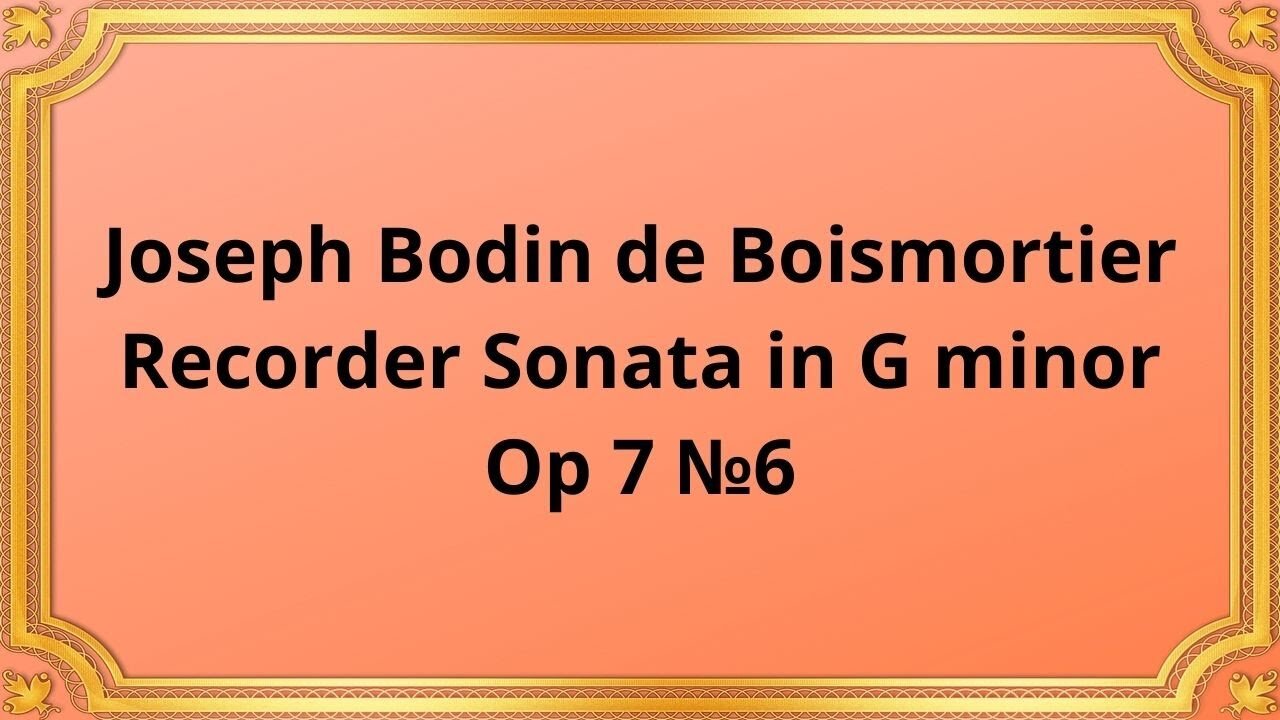Premium Only Content

Joseph Bodin de Boismortier Recorder Sonata in G minor, Op 7 №6
#Boismortier #RecorderSonata #BaroqueMusic #Opus7No6 #FrenchComposer #RecorderRepertoire
#SoloInstrumentSonata #GMinorSonata #ClassicalMusic
The Fontegara Amsterdam
Joseph Bodin de Boismortier, a French composer of the Baroque era, is known for his contributions to chamber music. His Recorder Sonata in G minor, Op. 7 No. 6, showcases his mastery of composition and the expressive potential of the recorder.
Joseph Bodin de Boismortier was a prominent figure in the French music scene during the 18th century. As a versatile composer, he wrote music for various instruments and ensembles, including the recorder. His compositions were characterized by their melodic beauty, refined style, and accessibility. Boismortier's music played a significant role in popularizing the recorder as a solo instrument during the Baroque period.
The Recorder Sonata in G minor, Op. 7 No. 6, follows a typical three-movement structure found in many Baroque sonatas. The first movement, marked Allegro, introduces the main themes and establishes the mood of the piece. It showcases Boismortier's gift for crafting elegant melodies and intricate counterpoint. The second movement, marked Adagio, brings a slower and more introspective atmosphere, allowing the recorder to express its lyrical qualities. The final movement, marked Allegro, is a lively and spirited dance, displaying the virtuosity of the performer and providing a delightful conclusion to the sonata.
Boismortier's Recorder Sonata highlights the expressive capabilities of the instrument. The recorder's sweet and mellow tone is well-suited to convey the graceful melodies and ornamentations present in the piece. Boismortier demonstrates his understanding of the recorder's technical possibilities, creating passages that explore the instrument's agility and dynamic range. The sonata showcases the recorder's ability to captivate audiences with its delicate yet vibrant sound.
The Recorder Sonata in G minor, Op. 7 No. 6, holds a significant place in the recorder repertoire. Boismortier's sonatas, including this one, played a crucial role in establishing the recorder as a solo instrument during the Baroque era. His compositions contributed to the development of the instrument's technique and showcased its expressive potential. Today, the sonata continues to be performed and appreciated by recorder players and enthusiasts, keeping Boismortier's music alive and contributing to the rich tapestry of Baroque chamber music.
Conclusion:
Joseph Bodin de Boismortier's Recorder Sonata in G minor, Op. 7 No. 6, stands as a testament to the composer's skill in writing elegant and charming music for the recorder. Its structure, musical themes, and the enduring legacy it holds in the recorder repertoire make it a significant contribution to the Baroque era. By exploring and appreciating this musical work, we gain a deeper understanding of Boismortier's talent as a composer and his influence on the development of the recorder as a solo instrument. Let us celebrate and embrace the beauty of this recorder sonata, ensuring that Joseph Bodin de Boismortier's musical legacy continues to be cherished and admired.
You have the opportunity to support the channel:
https://destream.net/live/RadSiarAl/donate
https://www.buymeacoffee.com/6355radsiaral
-
 34:38
34:38
Classical music_Music Inspiration
16 days agoSergei Rachmaninov Piano Concerto No. 2 in C minor Op. 18
35 -
 LIVE
LIVE
NeoX5
2 hours agoKhazan: The Road Less Taken | Part 5-2 | Rumble Studio | Rumble Gaming
176 watching -
 LIVE
LIVE
TwinGatz
8 hours ago🔴LIVE - He Is Doing His Best | ARMA Reforger
182 watching -
 54:40
54:40
LFA TV
12 hours agoSee God in the Trade War | TRUMPET DAILY 4.7.25 7PM
41.1K10 -
 1:18:30
1:18:30
Sarah Westall
5 hours agoNew Study: EMFs Literally Put You into a Brainwave Cage; Reclaiming your Mind w/ Ian & Philipp
45.3K14 -
 35:54
35:54
SantaSurfing
5 hours ago4/7/2025 - Trump Tariff impacts - he wants no Capital Gains Tax! Inflation falls to 1.22%!
32.9K23 -
 59:17
59:17
We Like Shooting
16 hours ago $0.09 earnedDouble Tap 404 (Gun Podcast)
22.4K -
 LIVE
LIVE
ZWOGs
10 hours ago🔴LIVE IN 1440p! - GRAPHIC DESIGN, Schedule 1, TARKOV, GTAV RP!! | Dwindle Digby | - Come Hang Out!
111 watching -
 4:51:28
4:51:28
Meisters of Madness
5 hours agoThymeSia - Power of the Plague
16.5K -
 1:13:25
1:13:25
Kim Iversen
8 hours agoAmerica First? Then Why Are We Funding This? | Empathy Is the Left’s Weapon—Here’s Why It’s Dangerous
129K137